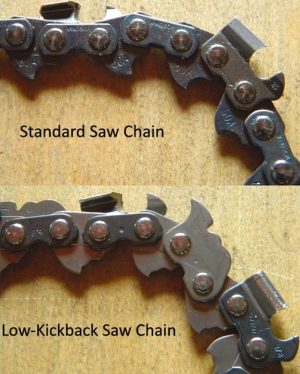Something I don't understand, why does that extra hump affect how it cuts? I mean, if both humps are the same height, why would it affect how it cuts?
As long as you're cutting on the flat part of the bar, and assuming the extra hump is at or below the level of the raker, it wouldn't really affect anything. However, when the extra hump flexes around the bar tip before the raker on the tooth, it effectively creates a bumper to keep the chain away from the wood. Hence why it's bad for bore cuts.
http://northernwoodlands.org/articles/article/tricks-of-the-trade11
"Some chainsaw chains are designed to minimize the reactive force known as kickback. These chains are found on a wide range of chainsaws made for homeowners, arborists, and loggers and are required to be sold on every new saw with an engine displacement of less than 66 cubic centimeters.
To understand how these chains work, let’s first review how a standard saw chain cuts wood fiber. Each cutter link has a heel, a toe, and, on the bottom half, rivet holes. On the top half, from front to back, you’ll find the depth gauge, the gullet, the cutting corner, the side plate, and the top plate. The depth gauge, which is sometimes erroneously referred to as the raker, does not clean out the chip the way a raker does on a crosscut saw. All the depth gauge does is set the depth or thickness of the chip that will be produced by the cutting corner when it hooks and then severs fiber. Depth gauges function as a safety feature, because by regulating the size of the chip, they also regulate the severity of reactive forces. The thicker the chip, the more severe the potential kickback.
To minimize the possibility of reactive forces, kickback-reducing features on chains limit the amount of fiber that can be hooked by the working corner as it rounds the upper half of the bar tip, which is commonly referred to as the kickback zone.
A common way to do this is to add an extra amount of metal onto the tie straps between the cutting teeth such that the tie strap functions as a higher depth gauge as the chain rounds the upper half of the bar tip. (Tie straps connect the cutting links with the drive links, and so-called bumper tie straps have a higher profile than regular tie straps to prevent the cutting tooth from hooking fiber.) Other anti-kickback approaches include drive links with built-in bumpers and ramped depth gauges so that fiber is somewhat deflected as the chain rounds the kickback zone. Chain must meet ANSI standard B175.1 to be designated as low-kickback.
There are two major drawbacks to low-kickback chain, the first being that it renders the kickback zone nearly useless for bore cutting. If your chainsaw work involves mostly bucking firewood, this is not likely to be a problem. It is, however, a problem if you are felling trees directionally using a bore cut to make your backcut (itself a safety technique intended to minimize “barber chair” and other dangerous felling situations). Because that upper half of the bar tip won’t cut well, bore cuts go very slowly if they go at all with low-kickback chain.
The second drawback to safety chain is that it can be more difficult to sharpen. If you take your saw to the dealer for sharpening anyway, this isn’t a problem, but if you sharpen the saw yourself and end up not keeping the chain suitably sharp, you’ll end up introducing a new risk factor – pressing down too hard on the saw in frustration – which can nullify the advantage of the safety chain in the first place. As with anything else, the key to a safety device is knowing how to use it correctly."
 No kidding! It only adds to the fun that they've changed and dropped letters in recent years...
No kidding! It only adds to the fun that they've changed and dropped letters in recent years... 







